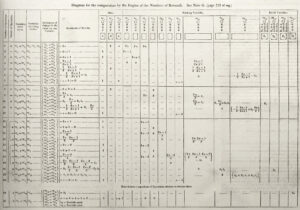
Today, artificial intelligence is ubiquitous. AI, and more generally, computer algorithms, are becoming the backbone of the global economy and society. Have you ever wondered: who wrote the world’s first computer algorithm?
Her name was Ada Lovelace.
Composing the World’s First Computer Program
Ada Lovelace (1815-1852) was the child of the Romantic poet Lord Byron and Annabella Milbanke Byron. With a keen interest in mathematics, Ada Lovelace was introduced in the 1830s to the mathematician Charles Babbage. Babbage was the inventor of the “analytical engine”, one of the most advanced computing designs at the time.
 Babbage traveled to Italy in 1840 to give a lecture at the University of Turin about the analytical engine. Based on the lecture, in 1842, the Italian mathematician Luigi Federico Menabrea published a description of the engine in French. Years later, Menabrea became the Prime Minister of Italy from 1867 to 1869.
Babbage traveled to Italy in 1840 to give a lecture at the University of Turin about the analytical engine. Based on the lecture, in 1842, the Italian mathematician Luigi Federico Menabrea published a description of the engine in French. Years later, Menabrea became the Prime Minister of Italy from 1867 to 1869.
Ada Lovelace then translated Menabrea’s publication into English. Beyond translation, she extensively augmented the paper with her own ideas and innovations in a series of notes, from A to G. In these notes, Ada Lovelace presented her vision of how the analytical engine could be programmed to perform a variety of complex tasks. In note G, in particular, she proposed a sequence of instructions, or, an algorithm, for leveraging the Analytical Engine to calculate Bernoulli numbers.
Note G is credited to be the world’s first computer algorithm, while Ada Lovelace is considered the first computer programmer in history.
Bridging the Art of Science with the Science of Art
In her notes, Ada demonstrated the vision and ability to bridge art with science, and, the art of science with the science of art. In particular, Ada Lovelace saw the future of computing, where the mechanisms of mathematics could be applied in diverse areas, beyond pure calculation. For example, she wrote:
 “[The Analytical Engine] might act upon other things besides number, were objects found whose mutual fundamental relations could be expressed by those of the abstract science of operations, and which should be also susceptible of adaptations to the action of the operating notation and mechanism of the engine. … Supposing, for instance, that the fundamental relations of pitched sounds in the science of harmony and of musical composition were susceptible of such expression and adaptations, the engine might compose elaborate and scientific pieces of music of any degree of complexity or extent.”
“[The Analytical Engine] might act upon other things besides number, were objects found whose mutual fundamental relations could be expressed by those of the abstract science of operations, and which should be also susceptible of adaptations to the action of the operating notation and mechanism of the engine. … Supposing, for instance, that the fundamental relations of pitched sounds in the science of harmony and of musical composition were susceptible of such expression and adaptations, the engine might compose elaborate and scientific pieces of music of any degree of complexity or extent.”
Today, consumer-facing AI applications such as OpenAI’s ChatGPT, DALL-E, and Sora make the vision of computers composing music, images, videos, and poetry almost a reality accessible for anyone. As we immerse ourselves in the digital world, when we study or work at a monitor, relax in front of a screen or behind a VR headset, or travel in autonomous or semi-autonomous vehicles or airplanes, we should never forget the contributions of Ada Lovelace, and generations of women who, despite barriers and biases in society, have shaped history, moved humanity forward, and made the world a better place.
***
Alley Oop’s newsletter
Every Friday morning Alley Oop arrives in your inbox with news and stories. To sign up, click here.
If you want to write to or contact Alley Oop’s editorial team, email us at alleyoop@ilsole24ore.com.